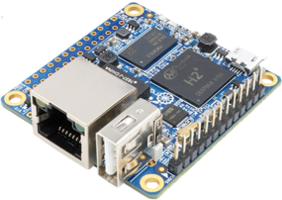|
Single-board computers Orange Pi
Means and tips:
|

|
| Parameters: | Orange Pi Zero |
|---|---|
| Hardware platform: | Cortex-A7 (ARMv7) |
| Central processor: | H2 Cortex-A7 H.265/HEVC 1080P, 1.2GHz, 4 Cores |
| Memory: | 256MB/512MB DDR3 SDRAM |
| Solid memory: | µSD, optional SPI NOR Flash on board |
| Video subsystem: | Mali400MP2 GPU @600MHz |
| Audio subsystem: | integrated to CPU |
| Electrical power: | DC 5V DC-IN via µUSB or pin headers or PoE |
| Interfaces: | 3xUSB Host, 1xUSB OTG, Ethernet 10/100M POE, WiFi 802.11 b/g/n, TV out, microphone, stereo line-out, 3xUART, 2xSPI, 2xI2C |
| Weight: | 26 g. |
| Size: | 48 × 46 × 17 mm |
| Hardware | CPU | Entry into JavaLikeCalc, us | Operation sin(Pi) [in JavaLikeCalc], us | Operation pow(Pi,2) [in JavaLikeCalc], us | Model AGLKS [Vision, main mnemo], %(core) | Extra tests and notes |
|---|---|---|---|---|---|---|
| Orange Pi Zero | ARM Cortex-A7, Allwinner H2(+), 40nm, 1.2 GHz, 4 Cores | 0.616 | 0.489 [0.554] | 0.625 [0.734] ** | - | Updated: 04.03.2023 Minimum power consumption (on 240MHz): 0.89W, 1.02W(+Eth), 1.15W(+WIFI) Performance for 1.29W, 240MHz: GPIO 1.2us RT: The realtime policies SCHED_RR and SCHED_OTHER are completely missing |
For working with the board there firstly were used a special distributive Armbian "Jessie". As builds of OpenSCADA there used the packages repository, mostly for the generic architecture ARMHF for which performs regular building of OpenSCADA by the Automatic Builder of OpenSCADA into the cross-compiling environment.
The board provides many low level buses (3xUART, 2xSPI, 2xI2C) despite its small size, and restricted GPIO in 16 pins which mostly used by the buses. The buses are standard ones but GPIO is a specific one and for that there was implemented special support in the available module DAQ.GPIO making it more unified one.
1 GPIO
| 2x13 Header | |||
|---|---|---|---|
| 1 | 3.3V | 2 | 5V |
| 3 | TWI0_SDA / PA12 / GPIO12 | 4 | 5V |
| 5 | TWI0_SCK / PA11 / GPIO11 | 6 | GND |
| 7 | PWM1 / PA06 / GPIO6 | 8 | UART1_TX / PG06 / GPIO198 |
| 9 | GND | 10 | UART1_RX / PG07 / GPIO199 |
| 11 | UART2_RX / PA01 / GPIO1 | 12 | SIM_CLK/PA_EINT7 / PA07 / GPIO7 |
| 13 | UART2_TX / PA00 / GPIO0 | 14 | GND |
| 15 | UART2_CTS / PA03 / GPIO3 | 16 | TWI1-SDA / PA19 / GPIO19 |
| 17 | 3.3V | 18 | TWI1-SCK / PA18 / GPIO18 |
| 19 | SPI1_MOSI / PA15 / GPIO15 | 20 | GND |
| 21 | SPI1_MISO / PA16 / GPIO16 | 22 | UART2_RTS / PA02 / GPIO2 |
| 23 | SPI1_CLK / PA14 / GPIO14 | 24 | SPI1_CS / PA13 / GPIO13 |
| 25 | GND | 26 | SIM_DET/PA_EINT10 / PA10 / GPIO10 |
| 1x13 Header | |
|---|---|
| 1 | 5V |
| 2 | GND |
| 3 | USB-DM2 |
| 4 | USB-DP2 |
| 5 | USB-DM3 |
| 6 | USB-DP3 |
| 7 | LINEOUTR |
| 8 | LINEOUTL |
| 9 | TV-OUT |
| 10 | MIC-BIAS |
| 11 | MIC1P |
| 12 | MIC1N |
| 13 | CIR-RX |
| LEDs | |
|---|---|
| Name | GPIO |
| Red LED | PA17 |
| Green LED | PL10 |